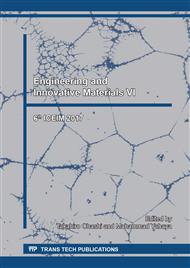p.73
p.80
p.89
p.94
p.99
p.104
p.109
p.114
p.120
Effect of Tool Path Parameters on Part Porosity in Fused Filament Fabrication of Poly(Ethylene-co-Trimethylene Terephthalate)
Abstract:
Poly(ethylene-co-trimethylene terephthalate) is an engineering material that has recently gained attention for use in fused filament fabrication (FFF). Although the properties of this thermoplastic are well suited for this process, the porosity of the components made remains a barrier to wider use of this approach in the additive fabrication of tight components for medical and food applications. This study investigated the effects of four tool path parameters of the FFF process – road width, air gap, layer thickness, and outer contours – on the void fraction in the structures made. It was revealed that the porosity was reduced from above 9% to below 2% when the extrusion rate was increased from initially 5.00 mm3/s to at least 5.75 mm3/s. A similar outcome was observed when a negative air gap between two adjacent strands of -15% or less was applied. In addition, these results were obtained without extending the print times. By contrast, altering the layer thickness and number of contours had only marginal or no effects on part porosity.
Info:
Periodical:
Pages:
99-103
Citation:
Online since:
January 2018
Authors:
Keywords:
Price:
Сopyright:
© 2018 Trans Tech Publications Ltd. All Rights Reserved
Share:
Citation:


